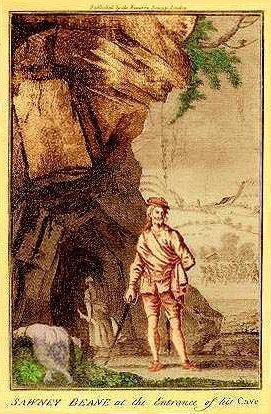
Sawney Bean & his cannibal clan would make a great opera
HumourEvery once in a while, one comes across a story that grabs a tight hold on your attention. If you’re a fan of combining music and theatre, one of your first reactions is to wonder whether or not that great story has yet been turned into an opera.
Example: the urban legend of Sawney Bean. Dated anywhere between the 13th and 16th centuries, the tale has Sawney Bean (or Beane) and his wife making their home in a cave at Bennane Head, along the southwestern coast of Scotland. Their incestuous clan of about 48 was reportedly responsible for the robbery, murder, and cannibalism of roughly 1000 people.

Yep, the Sawney Bean clan were cannibal cave dwellers, and if you saw The Hills Have Eyes, this story might sound familiar. The clan would pick off people traveling along the road nearby, kill them, take all of their stuff, and eventually eat them. They stayed out of sight in their cave, and no one who saw their faces ever survived (save for one man who was a good enough dueller to escape an attack).
As people kept disappearing, paranoia grew among the local townsfolk, leading to a few rash lynchings of innocent suspects. The investigation culminated in a formal manhunt led by King James VI of Scotland, and they not only found the Sawney Bean clan’s cave, but the hanging (and pickled, in some cases) human remains of their victims. The clan was arrested and sentenced to nasty deaths without trial.
There’s even a more localised spin-off story that came out of the legend: it’s said that one of Sawney Bean’s daughters left the clan and settled in the Scottish town of Girvan. There, she planted a Dule tree, which at the time was commonly used for lynchings; when her family was found and arrested, the people of Girvan found out who the daughter really was, and hung her from that same tree.
Now, that’s a tale. In truth, the gruesome acts of the Sawney Bean clan fall more probably in the category of legend than fact. The story didn’t really start to circulate until the 18th century, and at a time when England was aggressively spreading anti-Scottish propaganda.
Whether you turn Sawney Bean himself into a booming basso profundo with a mean snarl and a taste for human flesh, or you tell the story of an antisocial family living among a mob-like community with a tendency toward exaggeration and gossip, the story is full of operatic qualities. It could even be further removed from the legend itself, more of an after-the-fact look at how propaganda and false information come about - very timely indeed, although it’s likely the less juicy of the story-telling options.
The opera about Sawney Bean and his clan of cave-dwelling cannibals could a bit Peter Grimes and a bit Bluebeard’s Castle, with a score that takes full advantage of the Scottish musical aesthetic of centuries past. We’re officially putting it out there: composers/librettists, if you make this opera, we will be there with bells on.


Comments